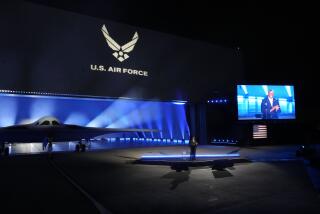Pentagon Studies Anthrax Vaccinations for Military
- Share via
WASHINGTON — The Pentagon is considering a plan to vaccinate large numbers of U.S. military personnel against anthrax, a deadly bacteria now routinely found among the biological weapons of potential U.S. adversaries, officials said Wednesday.
The proposal has the backing of the Joint Chiefs of Staff and is to go to Defense Secretary William J. Perry within days. Perry, however, has not decided whether to approve it.
Pentagon officials said they have not determined if the inoculations should be given routinely to all 1.5 million persons now in the military or only to those units most likely to be deployed in areas where there is a high risk of biological warfare attack.
If the program is approved, the first troops to receive the shots would be those deployed in the Persian Gulf and South Korea, followed by service members who are within 35 days of heading to those spots. The vaccine is administered through six inoculations over an 18-month period.
The inoculation proposal comes in a decade when the Pentagon has seen two major shifts in threats posed by adversaries. The end of the Cold War sharply curtailed the possibility of nuclear attack, allowing the Defense Department to devote more attention to other dangers. At nearly the same time, the 1991 Persian Gulf War brought American battlefield forces face to face with an arsenal of unconventional weapons for the first time since World War I.
If the vaccinations become standard, it would mark the first time that the U.S. military has routinely inoculated all personnel to guard against a germ-warfare agent. Officials said that a military-wide program could cost as much as $120 million a year.
But the use of the anti-anthrax inoculations is not new to the U.S. military. More than 150,000 troops were inoculated during the Gulf War and a handful of special units have been given the drug since 1970.
Pentagon officials said the vaccine has had no adverse side effects, either among military personnel or private-sector workers. It has been fully approved by the U.S. Food and Drug Administration.
The officials said that Great Britain and Russia already give mandatory inoculations to their troops. The vaccine is used routinely by veterinarians, laboratory workers and civilians who work with livestock. Anthrax is caused by bacteria found in cattle and sheep.
It has been considered an ideal agent for use in germ warfare because it is a spore-producing organism that can be stored indefinitely in dry form and then spread into the atmosphere through detonation or spray.
Defense experts said that, so far, only a handful of countries--including Russia, China, Iraq, Iran and Libya--is believed capable of launching attacks using anthrax. However, the technology is not complex, and the list of countries with anthrax weapons is expected to grow rapidly over the next several years.
The decision to begin the inoculation program, if approved by Perry, would represent a reversal among top defense officials. The Joint Chiefs of Staff had argued earlier that the military should wait for development of a multipurpose vaccine that could be used to counter a variety of biological agents, including anthrax.
Officials said that some military leaders also had questioned the need to spend the estimated $120 million for inoculations, arguing that the United States could instead ward off a biological attack simply by threatening massive retaliation.
Pentagon officials insisted that the timing of the proposal was not related to the current controversy over possible exposure of U.S. troops to toxic agents after the Persian Gulf War. New evidence from a United Nations commission has forced the Pentagon to reverse its long-standing assertion that no U.S. troops were exposed to chemical agents in that region. Officials now estimate that at least 15,000 American soldiers may have made contact with toxic gas.
Officials said that the debate over an anti-anthrax inoculation has been going on for months and is part of a long-term push by the military to equip U.S. troops to deal with attacks from weapons of mass destruction. The vaccination program was first described in Wednesday’s editions of the Washington Post.
Anthrax can be deadly in humans, especially when a person inhales the organism.
“It is a disease that is very highly lethal if you breathe in the spores and they germinate in your lungs,” said Dr. John LaMontagne, director of the division of microbiology and infectious diseases at the government’s National Institute of Allergy and Infectious Diseases.
“You get a massive bacterial infection, pneumonia, you start bleeding in the lungs, you go into shock very quickly--and you die,” he added. “It’s a bad disease.”
An individual can incubate the disease for a few hours to a week; most become sick within 48 hours of exposure and death can occur within days.
Anthrax can be treated with a wide range of antibiotics, “but not easily if it’s in the lungs,” LaMontagne said.
The disease also can be acquired through the skin and the gastrointestinal tract but is less serious in those sites, he said.
The vaccine that protects against anthrax was licensed in 1970 to the Michigan Department of Public Health for use in agricultural workers and is designed to neutralize toxins produced by the organism in the body, experts said. It is considered to be very effective.
It is useless, however, if administered after exposure to the organism. Among the vaccine’s minimal side effects is local, reversible swelling at the point of the injection. The vaccine has caused malaise and fatigue in fewer than 0.2% of those receiving it, and chills and fever in only a few cases, according to the labeling information on the product.
Separately, U.S. officials confirmed a report in today’s editions of the New York Times that before the Gulf War ground assault began, American warplanes bombed an ammunition storage area in Khamisiyah, Iraq, that contained chemical weapons. The site is the same one the Pentagon has said held the weapons whose destruction after the war by U.S. personnel on the ground may have exposed more than 15,000 U.S. troops to toxic substances.
Officials said there is no evidence that the bombing at Khamisiyah hit any of the chemical weapons or that U.S. troops were affected. The chemical weapons were concentrated in a bunker and an accompanying ammunition pit several miles away, officials said. Both appeared to be intact when U.S. ground troops moved after the war.
The officials said the nearest U.S. troops at the time of the bombing most likely were in Saudi Arabian staging areas, at least 110 miles from Khamisiyha--said to be almost certainly too far away to be affected by nerve-gas vapors that might have been carried across the desert by the wind.
More to Read
Sign up for Essential California
The most important California stories and recommendations in your inbox every morning.
You may occasionally receive promotional content from the Los Angeles Times.













